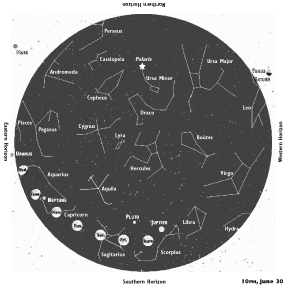Bright Lights at the Edge of Night
Venus and Saturn put on a show 
Saturday’s full moon rises in the southeast at 9:15pm as the sun sets opposite in the northwest. Called the Hay Moon, the Rose Moon, the Strawberry Moon and the Honey Moon, June’s full moon is the lowest of the year, arcing deep in the southern sky.
Around the witching hour between Saturday and Sunday, the moon is due south, barely 20 degrees above the horizon. Twelve hours later, the sun shines directly overhead. Six months from now, the position of December’s full moon and the sun will be reversed, with the sun its lowest in the south and the brilliant winter moon directly above.
Twilight Saturday brings more than the full moon. For weeks, Saturn has been nearing Venus. This evening the two appear almost as one with less than one degree separating the two above the west-northwest horizon.
As Saturn and Venus glimmer brightly, there is no mistaking the two. Armed with binoculars or a small telescope, which will allow you to see both in the same field of view, the differences are even more dramatic.
While Saturn is 10 times larger than Venus, it is also more than 12 times farther from the sun and almost 10 times farther from Earth. As a result, far less sunlight reaches the ringed planet in the first place, and what is reflected back to Earth is diffused over much more space. Additionally, although a gaseous giant that would float in water, Saturn absorbs more light than Venus, whose cloud-shrouded surface reflects all but two percent of the sunlight that hits it.
Sunday the two planets are still within one degree of one another, but thereafter Saturn sinks fast, disappearing from view by the end of July with Venus following two weeks later.
Tidelog®
Illustration: © Copyright 1925 M.C. Escher/Cordon Art-Baarn-Holland; Graphics: © Copyright 2007 Pacific Publishers. Reprinted by permission from the Tidelog graphic almanac. Bound copies of the annual Tidelog for Chesapeake Bay are $14.95 ppd. from Pacific Publishers, Box 480, Bolinas, CA 94924. Phone 415-868-2909. Weather affects tides. This information is believed to be reliable but no guarantee of accuracy is made by Bay Weekly or Pacific Publishers. The actual layout of Tidelog differs from that used in Bay Weekly. Tidelog graphics are repositioned to reflect Bay Weekly’s distribution cycle.Tides are based on National Oceanic and Atmospheric Administration and are positioned to coincide with high and low tides of Tidelog.
